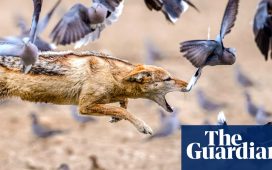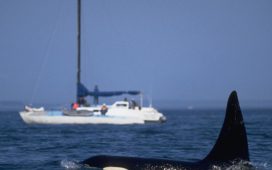
Tourists are warned not to feed Japan’s famous wild deer after several died after swallowing plastic bags.
Nine of the 14 deer that have died in Nara Park since March were found to have large amounts of plastic in their stomachs, according to the Nara Deer Preservation Foundation.
One of the animals was found to have swallowed 4.3kg (9.4lbs) of plastic, Kyodo news agency reports.
It is believed the deer are attracted to the scent of food coming from plastic bags and wrappers left in the area by tourists.
The popular park, which spans 5,000sqm, is home to about 1,200 sika deer.
1/17 Amur Leopard
Endemic to the far east of Russia, the Amur Leopard has a population of around 84 and is critically endangered. Here follows every species that the WWF lists as critically endangered.
Getty
2/17 Yangtze Finless Porpoise
Endemic to China’s Yangtze River, the Yangtze finless porpoise has an estimated population of 1000-1800
Kenichi Nobusue
3/17 South China Tiger
When discovered in the 1950s, the South China tiger population was estimated to be 4000, by 1996 it was estimated to be only 30-80. Scientists consider the tiger to be “functionally extinct” as one has not been sighted for over 25 years
4/17 Sumatran Orangutan
The Sumatran orangutan was once found across the island of Sumatra and even further south on Java. Today it is found only in the island’s north and its population stands at 14,613
Getty
5/17 Western Lowland Gorilla
Though it is the most populous of all gorilla subspecies, the western lowland gorilla is still critically endangered and its population has declined by 60% in the last quarter century
Getty
6/17 Sumatran Rhinoceros
The Sumatran rhinoceros is the smallest of the surviving rhinoceros species. Only 80 are known to be living today. The last male Sumatran rhino in Malaysia died on 28 May 2019
Willem V Strien
7/17 Sumatran Tiger
There are fewer than 400 Sumatran tigers left today. They are severely threatened by deforestation and poaching
Getty
8/17 Eastern Lowland Gorilla
Half of the rainforest of the Democratic Republic of Congo in which these gorillas live has been destroyed the past 50 years. There were 17,000 Eastern Lowland gorillas in the 1990s but scientists estimate their population has declined by over 50% since then
Getty
9/17 Vaquita
The world’s rarest marine animal has a population of only 30. They were discovered in 1958 and are endemic to Mexico’s Gulf of California
Paula Olson / NOAA
10/17 Javan Rhino
The most threatened of all rhino species, there are only an estimated 58-68 Javan rhino left
Reuters
11/17 Saola
The saola was first sighted in 1992, being the first large mammal to be discovered in over 50 years. Scientists have only sighted saola in the wild four times and it is considered critically endangered
12/17 Sumatran Elephant
The Sumatran elephant population now stands at only 2400-2800
Getty
13/17 Malayan Tiger
The Malayan Tiger population now stands at only 250-300
Getty
14/17 Hawksbill Turtle
The population of the Hawksbill Turtle has declined by more than 80% in the last century. They are threatened by black market poachers who kill them for their shell
Getty
15/17 Black Rhino
The population of the black rhino dropped by 98% in the years 1960-1995 due to poaching, it stands today at around 5000
Getty
16/17 Cross River Gorilla
The population of the Cross River gorilla has been damaged by deforestation and poaching, it now stands at 200-300
Julie Langford
17/17 Bornean Orangutan
The population of the Bornean orangutan has been reduced by over 50% in the past 60 years, now standing at around 104,700. Their habitat has been reduced by at least 50% in the 21st century
Getty
1/17 Amur Leopard
Endemic to the far east of Russia, the Amur Leopard has a population of around 84 and is critically endangered. Here follows every species that the WWF lists as critically endangered.
Getty
2/17 Yangtze Finless Porpoise
Endemic to China’s Yangtze River, the Yangtze finless porpoise has an estimated population of 1000-1800
Kenichi Nobusue
3/17 South China Tiger
When discovered in the 1950s, the South China tiger population was estimated to be 4000, by 1996 it was estimated to be only 30-80. Scientists consider the tiger to be “functionally extinct” as one has not been sighted for over 25 years
4/17 Sumatran Orangutan
The Sumatran orangutan was once found across the island of Sumatra and even further south on Java. Today it is found only in the island’s north and its population stands at 14,613
Getty
5/17 Western Lowland Gorilla
Though it is the most populous of all gorilla subspecies, the western lowland gorilla is still critically endangered and its population has declined by 60% in the last quarter century
Getty
6/17 Sumatran Rhinoceros
The Sumatran rhinoceros is the smallest of the surviving rhinoceros species. Only 80 are known to be living today. The last male Sumatran rhino in Malaysia died on 28 May 2019
Willem V Strien
7/17 Sumatran Tiger
There are fewer than 400 Sumatran tigers left today. They are severely threatened by deforestation and poaching
Getty
8/17 Eastern Lowland Gorilla
Half of the rainforest of the Democratic Republic of Congo in which these gorillas live has been destroyed the past 50 years. There were 17,000 Eastern Lowland gorillas in the 1990s but scientists estimate their population has declined by over 50% since then
Getty
9/17 Vaquita
The world’s rarest marine animal has a population of only 30. They were discovered in 1958 and are endemic to Mexico’s Gulf of California
Paula Olson / NOAA
10/17 Javan Rhino
The most threatened of all rhino species, there are only an estimated 58-68 Javan rhino left
Reuters
11/17 Saola
The saola was first sighted in 1992, being the first large mammal to be discovered in over 50 years. Scientists have only sighted saola in the wild four times and it is considered critically endangered
12/17 Sumatran Elephant
The Sumatran elephant population now stands at only 2400-2800
Getty
13/17 Malayan Tiger
The Malayan Tiger population now stands at only 250-300
Getty
14/17 Hawksbill Turtle
The population of the Hawksbill Turtle has declined by more than 80% in the last century. They are threatened by black market poachers who kill them for their shell
Getty
15/17 Black Rhino
The population of the black rhino dropped by 98% in the years 1960-1995 due to poaching, it stands today at around 5000
Getty
16/17 Cross River Gorilla
The population of the Cross River gorilla has been damaged by deforestation and poaching, it now stands at 200-300
Julie Langford
17/17 Bornean Orangutan
The population of the Bornean orangutan has been reduced by over 50% in the past 60 years, now standing at around 104,700. Their habitat has been reduced by at least 50% in the 21st century
Getty
They are considered sacred and have protected “national treasure” status.
Tourists flock to the area in the hope of seeing the deer bow, which they have learnt to do in exchange for food.
However, the public is warned to only feed the animals shika senbei snacks (Japanese rice crackers), which are sold in environmentally-friendly packaging from local stalls.
Vet Rie Maruko, who is a member of the preservation foundation, said he was able to feel the bones of the dead deer since they were so malnourished, Kyodo reports.
The foundation tweeted an image of a pile of plastic bags found inside the stomach of one of the dead deer with the warning: “Don’t throw away rubbish in Nara Park!”
The local government plans to do more to warn tourists not to feed the deer with anything other than the designated crackers.












